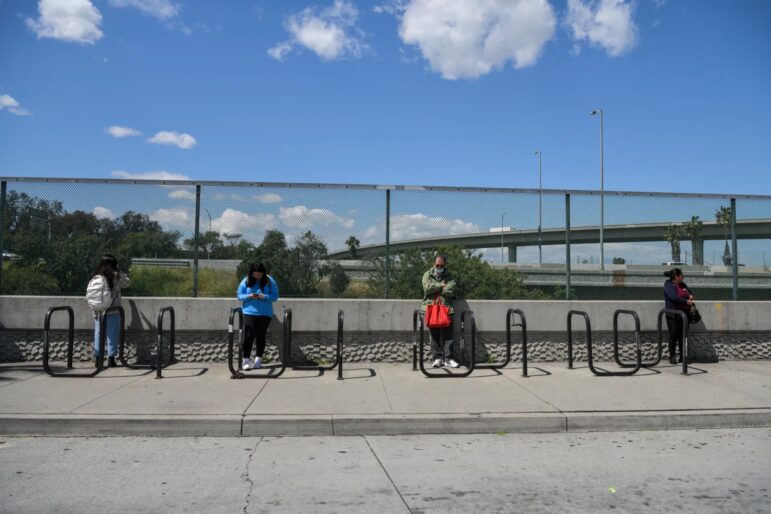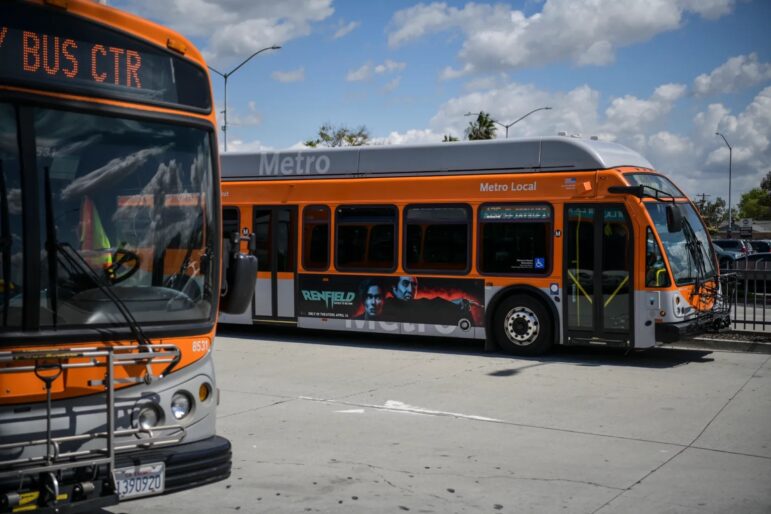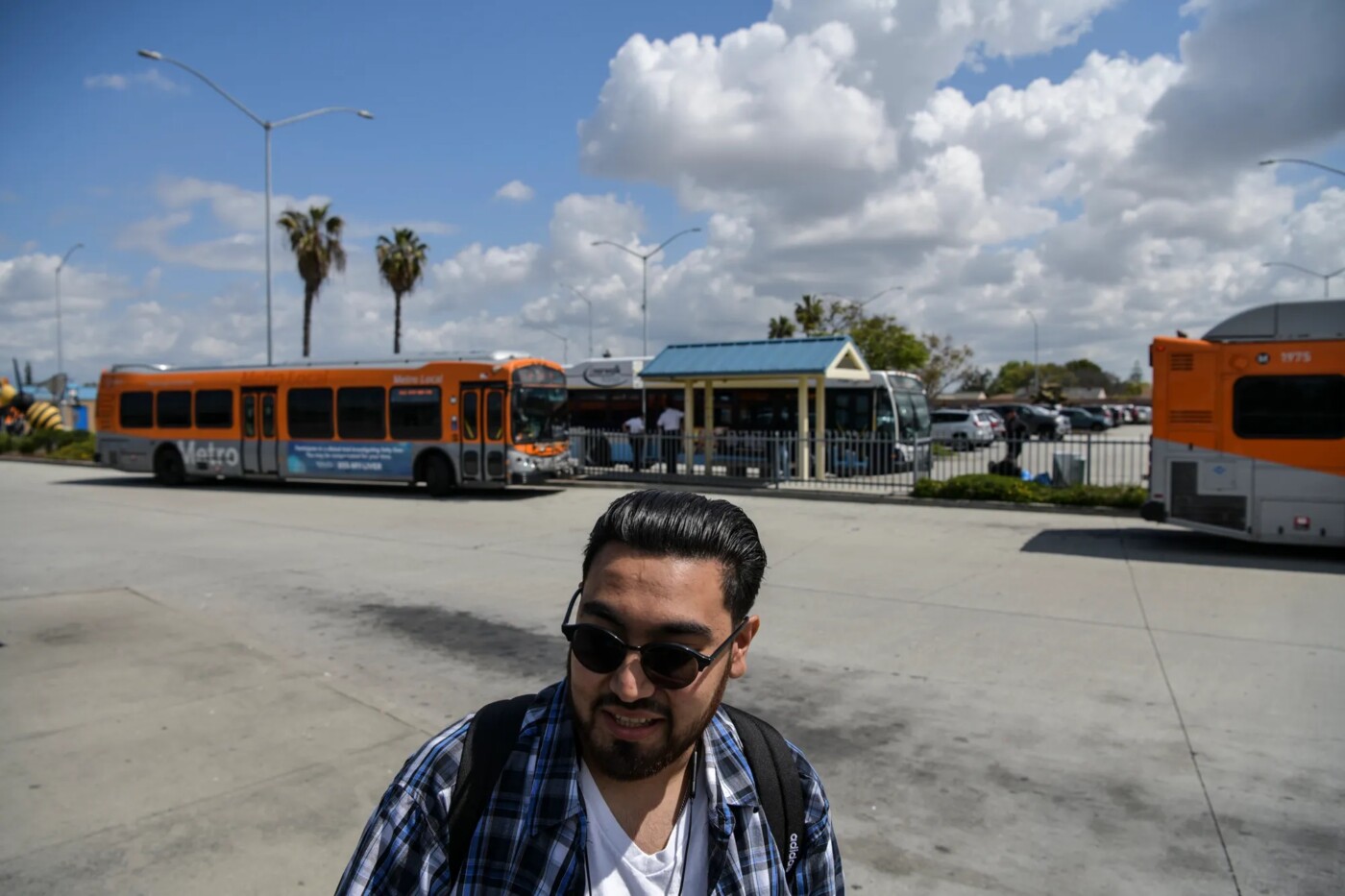For 22-year-old Henry Sanchez, a 25-cent increase in the bus fare makes a big difference.
It used to be $1.50 to get from his home in Bell Gardens to Cerritos College, where he studies. Now, it’s $1.75 one-way.
“It really sucks that you have to worry about the price going up, while the quality of the services is going down,” he said at the Metro Rail station in Norwalk this week. “And trying to buy a car is harder, even getting a used car. It’s risky.”
Does he think the state should step in to help public transit systems avoid fare hikes? It could help, he said — unless that means higher taxes or the price of other things going up.
Sanchez isn’t alone in his quandary.
Transit agencies across California are grappling with a “fiscal cliff” — a decline in revenue and the end of federal funding that has been a lifeline for the last three years. Without the state stepping in, they say they may have to cut service or increase fares.
That would hit low-income people the hardest, especially those who rely exclusively on transit to get around. Any major changes would also affect commuters, the other regular group of riders.
Transit has been hit by previous downturns, including during the 2008 Great Recession, but the COVID-19 pandemic took a bigger toll. Ridership was already on the decline as early as 2013, but dropped dramatically when the pandemic began in March 2020 — and, unlike after the recession, hasn’t fully recovered.
Statewide, monthly ridership dropped from 100 million in February 2019 to about 20 million in June 2020. As of June 2022, the numbers rebounded to about 60 million, but varied by region and transportation mode.
The fares that riders pay not only help keep buses and trains running, but help agencies qualify for state and federal grants. Transit agencies say that the federal funding they’ve received during the pandemic will run out within two years.
Looking ahead, state regulations that phase out vehicles that use gasoline and diesel fuel will also reduce the tax revenue paid to transit agencies, putting more stress on their finances.
The Legislature and Gov. Gavin Newsom are drafting next year’s budget, and to help cover a deficit projected to be as much as $25 billion, Newsom is proposing delays and cuts to some transit expansions and equipment programs. That doesn’t directly impact operations, but it prompted some lawmakers to call for the state to step in with more money — while others are hoping transit agencies will be held more accountable for how they’ve spent funds.
It’s a pivotal moment for not only current services, but for the long-term future of transit in the state.
“This is a moment that is making all the difficulties that we have been having for years in public transportation in the U.S. really kind of come up,” said Giovanni Circella, a program director at UC Davis’ Institute of Transportation Studies.
There’s also the climate angle: California’s transportation sector accounts for about 40% of the state’s carbon emissions.
Getting more people out of their own gas-powered cars is essential to meeting the state Air Resources Board’s goal to reduce greenhouse gas emissions 48% below 1990 levels by 2030. In 2018, the board adopted a regulation that calls for all new buses to be carbon-free by 2029.
Compared to a car with only a driver, subways produce 76% less in greenhouse gas emissions per passenger mile, light rail systems 62% less, and buses 33% less, according to the U.S. Transportation Department. Those are averages; the environmental payoff from public transit depends on the number of passengers and the type of fuel used..
Public transportation in the United States saved 63 million metric tons of carbon dioxide emissions in 2018 — the equivalent of taking 16 coal power plants offline for a year, according to a report from the National Academies of Sciences, Engineering, and Medicine.
“A focus on farebox recovery somewhat misses the mark on what transit agencies are actually doing,” said Michael Pimentel, executive director of the California Transit Association, which represents transit agencies. “Efficiency is an important criteria, but so, too, are environmental benefits and making advances on equity.”
To really reap the climate benefits and get cars off the road, California’s public transit systems need to be popular and running efficiently — and that isn’t happening in many places.
Here’s how we got here — and what some suggest can be done.
The problems (and it’s not just money)
Transit agencies rely on a mix of funding sources — federal grants, state funding, revenue from local taxes and passenger fares.
The agencies that rely more heavily on fares are the ones in the most dire situations. That includes Bay Area Rapid Transit, San Francisco’s MUNI and Los Angeles Metro.
BART ridership dropped from more than 118 million in fiscal year 2019 to about 35 million in 2022, according to the agency. In 2019, BART’s passenger fares and parking revenues totaled $520 million, funding 66% of its operations. That number dropped to 12% in 2021, and rebounded slightly last year to 21%, with passenger fares and parking totaling $147 million.
The agency received $1.6 billion through three rounds of emergency federal aid. Initial funding was limited to spending specifically on COVID-19 measures, such as emergency protective gear for employees and covering administrative leaves, but later grants allowed spending on operations. And while that funding has helped restore service to pre-pandemic levels, the system still encounters delays and cancellations, in part due to an ongoing labor shortage.
According to Brian Taylor, director of UCLA’s Institute of Transportation Studies, many transit operators retired or shifted to work with lower health risks, such as trucking. A national survey by the American Public Transportation Association in March 2022 found that retirees made up 24% of all workers who quit, while 45% left for jobs outside of the transit industry.
Taylor said one factor behind the departures is that drivers don’t want to take on the increasing role of policing behavior — first enforcing mask rules and later dealing with growing mental health, drug, and homelessness crises showing up on public transit.
Those problems aren’t just keeping transit drivers away. At a legislative committee hearing in March, transit agency officials said the issues are also scaring off riders.
Since Jan. 1, 26 people have died on Metro buses and trains from suspected drug overdoses — already four more than the total deaths from any cause in all of 2022. And serious crimes — such as robbery, rape, and aggravated assault — were up 24% compared to 2022.
Safety concerns add to the longstanding issues that discourage people from using public transit: how long trips take, the inconvenience of getting to a station and delays or interruptions.
It doesn’t help that some transit agencies are not being managed very well.
Recent probes of BART revealed conflict-of-interest violations, a BART employee who faked work hours and a $350,000 homeless outreach program with the Salvation Army that got only one person into a residential treatment facility after two years, according to local press reports.
In 2022, the Alameda County Grand Jury found the agency’s board, management, and unions engaged in a “pattern of obstruction” against its Office of the Inspector General, which oversaw those probes.
The string of problems prompted State Sen. Steve Glazer, a Democrat from Orinda and a vocal BART critic, to resign from a legislative select committee that is advocating for more state transit funding.
BART, said Glazer, is beset by “a breakdown of all kinds of levels.”
“It’s not just about the trains, it’s a breakdown in their safety, a breakdown in oversight. It’s violations of the law.… it’s fake (security) cameras on trains, you know, massive overtime … the cost overruns, the delays,” he said.
“I’m not supportive of bailing out BART when they refuse to have fiscal oversight through a fully functioning Office of Inspector General,” he added.
In response, BART spokesperson Jim Allison said the agency supports independent oversight, and that officials “learned a lesson” from their contract with the Salvation Army.
“The outgoing inspector general is an expert in finding fraud and abuse and waste. She does not have any experience in terms of operating a railroad,” he said.
Allison also said the “fiscal cliff” BART is facing is due to high fixed costs rather than mismanagement. “We’re not going to be able to cut our way out of this financial crisis,” he said. “We just have naturally built-in costs that we need to address to keep the system in a state of good repair.”

BART isn’t the only agency to come under fire.
Assemblymember Marc Berman, a Democrat from Palo Alto, requested an audit of the Santa Clara Valley Transportation Authority, based on concerns about the agency’s leadership that he said resulted in operational and financial issues.
But not everyone finds the future of public transit in California as bleak.
San Jose-based advocate Monica Mallon disagreed with Berman’s call for the audit, saying that while VTA has handled its finances poorly in the past, it has learned from its mistakes. And no agency should be punished for external factors such as the pandemic, she added.
“If we let agencies fall off this cliff, it’s going to be really hard to get transit back in the future,” Mallon said. “And then everybody’s going to be in traffic and complaining.”
In Sacramento, Dan Allison, an action team member of Sacramento Transit Advocates and Riders, said Regional Transit’s outlook doesn’t seem as dire as some other agencies’ and has improved service over the years.
Like Sacramento, the Humboldt County transit authority is less dependent on fares for operations. Money is always an issue, said Greg Pratt, general manager, but the authority still plans to cut fares to attract new riders after a decline during the pandemic.
The solutions (and it’s mostly money)
Short-term solutions include more state money for “bridge funding” to help transit agencies avoid the “fiscal cliff.”
California’s largest systems receive less state support than other systems of their size nationally, according to an analysis by the nonprofit policy group San Francisco Bay Area Planning and Urban Research Association. In 2019, the state’s largest operators received 5% to 22% of operating funding from the state, whereas large systems in other states received 28% to 50%.
The financial crisis should not come as a shock to the state, according to Eli Lipmen, executive director of rider advocacy group Move LA.
“We knew this was coming,” he said. “We’re in a new paradigm where we need to rethink how we fund public transit because it can’t necessarily be funded by a farebox.”
The California State Transportation Agency said it is “aware of the challenges that transit operators are facing as the state transitions to a post-pandemic transit environment” and while Newsom’s budget does not include any money for transit operations, it hopes to continue working toward solutions that “will preserve and improve the state’s transit system and work toward long-term financial stability.”
It’s typically an easier sell for agencies to score funding for expansion projects from the state. But the Legislature could also change the law to temporarily allow some project and equipment funding to be used for operations, as the Legislative Analyst’s Office suggested in its February report.
That doesn’t include shifting any high-speed rail funding, though, because the voter-approved bond measure that funds it can only be used for that purpose.
There’s also the option of local ballot measures to increase funding, but they take time, and voter approval isn’t guaranteed.
The Metropolitan Transportation Commission, which serves nine Bay Area counties, may put a regional transit funding measure before voters in 2026. (That worked in Los Angeles County in 2016, when voters overwhelmingly approved a permanent half-cent sales tax measure expected to raise $120 billion over 40 years).
But just filling short-term funding gaps won’t be enough.
Researchers, lawmakers and advocates agree that the future of public transit is tied to the recovery of downtowns. That means revising zoning and development laws — for example, building housing closer to transit, and easing parking requirements that increase the cost of those units.
In downtown San Francisco, for instance, the office vacancy rate shot up to nearly 28%, and that trend isn’t likely to end soon. One option would be to convert office space into housing, though that has its own set of roadblocks.

Some also call for fixes to the transit funding model, itself.
According to a February report from UCLA’s Institute of Transportation Studies, although populations and mobility patterns have changed since the Transportation Development Act was enacted in 1971, the law and its related programs have kept the same eligibility conditions based on counties and their populations in 1970. The outdated population numbers may also explain why transit agencies have increased in number: three of California’s four largest regions have fewer people per agency than the national average.
At the legislative hearing in February, state Sen. Aisha Wahab, a Fremont Democrat on the transportation committee, inquired about consolidation of transit agencies. UCLA’s researchers also called for better coordination of State Transit Assistance funding, and revamping how agencies are evaluated.
But not everyone is on board with investing more money into transit.
Assembly Republican Leader James Gallagher, from Chico, tweeted his skepticism today about the state bailing out a service that “didn’t pencil out before COVID,” “shirks oversight and allows fraud, and no one wants to ride because of drugs and vagrancy.”
Former U.S. Rep. Doug Ose, who ran in the 2021 gubernatorial recall election, also questions why any government should fund a program that “very few people want.”
“We might as well be buying a horse and buggy for everyone,” he tweeted Tuesday. “Public transit is no longer about moving people,” but has “become a jobs program for bus drivers no one needs.”
For transit to be a viable and attractive option, there are also passenger-oriented changes that have been proposed or put in place: easier transfers between different agencies, quicker payment options such as Google or Apple Pay, and door-to-door vans and other “microtransit” options to compete with ride-sharing companies.
Move LA also advocates for free fares for students to “create this next generation of transit riders who can sustain the system going forward,” Lipmen said.
A few agencies have already begun to deploy more police officers or mental health counselors on buses, though some debate the merits of increased police presence. One bill introduced this session would require large agencies to start collecting data on harassment of riders.
Assemblymember Laura Friedman, a Democrat from Burbank and chairperson of the transportation committee, introduced a bill that aims to make sure social service providers that receive state homelessness grants address the needs of homeless individuals using public transit.
She also introduced a bill that creates a task force to research and make recommendations on transit funding.
“We need to reimagine our stations, reimagine how we finance transit and find ways of building in public support,” she said. “It’s past time.”
